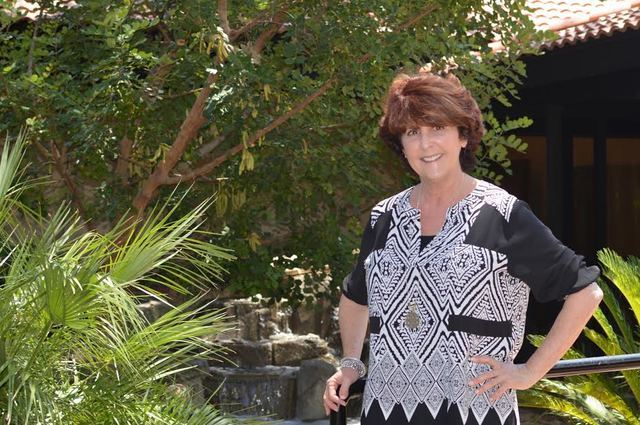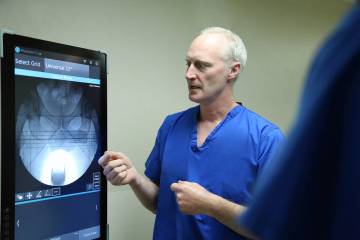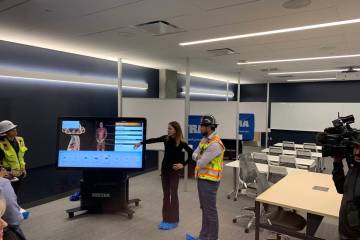
For more than a decade, Carole Fisher has led Nathan Adelson Hospice. But recent changes in the health care landscape are making the job more challenging.
As CEO and president, she oversees daily operations. Fisher holds a degree in social work from UNLV and has spent most of her career in leadership roles. She’s originally from Philadelphia, but says, “I raised my daughter here. … I feel like a native.”
Fisher says she was drawn to Nathan Adelson Hospice because she wanted to return to a “mission-driven” organization.
Nathan Adelson Hospice was named for a Sunrise Hospital administration official whose painful fight with cancer inspired the community. After the death of Nathan Adelson — no relation to Sheldon Adelson of Sands Corp. — his close friends, including developer Irwin Molasky, researched hospice care and helped bring it to Las Vegas more than 36 years ago.
Q. How did the recession affect Nathan Adelson Hospice?
A. The recession certainly was a really challenging time for us. It was a time when we had to really sharpen our skills and make sure our quality of care was never impacted. We had to be mindful of our financial resources. We did a lot back in 2008 to improve upon the work we were doing and tighten up a little bit.
As a mission-driven organization, you’re leading with this cause and purpose but you have to balance that with good business sense. The recession actually became an opportunity for us to sharpen our business acumen side of the organization.
While we saw some decline in contributions, the donors really supported us in many ways, some working at bedsides. They couldn’t afford to maybe give money but they would volunteer. It didn’t take long for us to turn that around. We approach problems as opportunities.
Q. How many volunteers serve Nathan Adelson Hospice?
A. We have over 300 volunteers that do nothing but volunteer at bedside or they do administrative work. Most of our volunteers have had personal experience with the hospice. Most have lost a loved one and we encourage people not to volunteer that first year. Give yourself time to grieve and be bereaved and then join us. It can be really hard and a challenging time for folks when they’re grieving. We care for several hundred patients every day and support their family members.
Q. What is the Elaine Wynn palliative program?
A. In hospice, you have a diagnosis of six months or less. That doesn’t mean people are going to end their life in six months. And you’re not pursuing curative treatment. Palliative medicine, those patients have symptoms that need to be managed. Physical, emotional, family dynamics, things that are associated with a life limiting illness but they’re still pursuing curative treatment.
Because of Elaine Wynn’s, and her daughter’s, generosity we were able to provide palliative care. We’re in the majority of every hospital doing consultations with patients. Help first and formost with their pain. In hospice and palliative medicine, we’re the experts in managing pain. We go in and relieve the suffering of those patients.
We also have a way for those patients to follow us in a clinic setting. We have two outpatient clinics — one at Touro University and one at Mill &McKinsey. Patients can come there and receive a follow-up visit. Then we provide palliative in the home.
It’s a wonderful way to bridge the gap in the health care system.
Q. What are some of the major challenges that you face in your day-to-day job?
A. We’re going through what I call the perfect storm right now. Medicare, they continue to reimburse us less and less. So about 75 (percent) to 80 percent of our patients are covered by Medicare. With less reimbursement, you’re having to do more for less. There’s over 45 hospices in our community. We’re the largest. We’re the only not-for-profit. But the competition has wreaked some havoc in our organization.
Many physicians that are aligned with these for-profit hospices also have access to patients in their day-to-day life. So they could have their own physician practice or they’re working for a hospital, or they’re working for a health care system.
It makes it more challenging to access patients these days. The regulatory environment has really turned up their oversight and overview. So we have to put more resources into our organization that are not touching the patient, are not at the bedside. So that makes it a little bit more challenging.
Our donors have always and continue to be major supporters of our organization. That’s going really well for us. We raise over $3 million a year to support a variety of programs and services.
Q. What types of patient perks does Nathan Adelson Hospice offer?
A. We have a meal delivery program, in conjunction with Three Square. We partner with them. People that are caring for patients at home, the loved ones, they may not always have what they need to take care of themselves because they’re working full time or some folks just don’t have financial resources for good nutrition. So we bring meals into the homes.
We have our Bonnie Schreck complementary therapies program, which is one of a kind in Southern Nevada. We do massages for patients, we do reiki, we do healing touch, we do art therapy, we do music therapy, and we have a pet therapy program.
Q. What kinds of things do you do to get the community involved?
A. It’s not hard for us to embrace our community. We have terrific name recognition. People are really aligned with our cause and our purpose. We do continue to do a lot to educate the community about us being here, about the need for hospice.
We’re getting ready to roll out a program called Deciding Tomorrow Today. It’s an advanced directive program. We believe that we have responsibility to help people make decisions prior to them being sick. An advanced directive program really helps with that. We’re devising a tool kit and helping people make those decisions and have those conversations with their family members and loved ones before they’re in a situation where they can’t speak for themselves.
Q. What events have become most popular with the public?
A. Every year we do a butterfly release in Las Vegas and we do one in Pahrump. People come together. It’s really grown. It’s a fabulous event. You buy a butterfly and we do a ceremony, especially focused on children. The community comes together and they release their butterflies all at one time. It’s a wonderful way of honoring their loved one in a visual setting. It’s not really about money as much as it’s about generating togetherness.






